Managerial Accounting Report: Costing Methods Analysis
VerifiedAdded on 2023/04/23
|16
|2574
|281
Report
AI Summary
This report provides a comprehensive analysis of managerial accounting, focusing on two primary costing methods: traditional costing and activity-based costing (ABC). It begins with an introduction to both methods, highlighting their differences in accuracy and complexity, with the traditional method being simpler but less accurate. The report then details the calculation of cost per unit using both methods, presenting the results in tabular form and comparing the outcomes. It includes profit and loss statements under both costing systems and explores the reasons behind the overseas buyer's preference for the advanced model. The report also examines the concepts of over and under absorption costs, including the ways these costs are treated in accounting. The report concludes with a discussion on the merits of accurate product pricing and the importance of selecting appropriate costing methods for informed decision-making. The report is based on an assignment brief from ACC200 and addresses the specific challenges faced by Fantori Ltd, a sewing machine manufacturer, in its costing practices and buyer interactions.
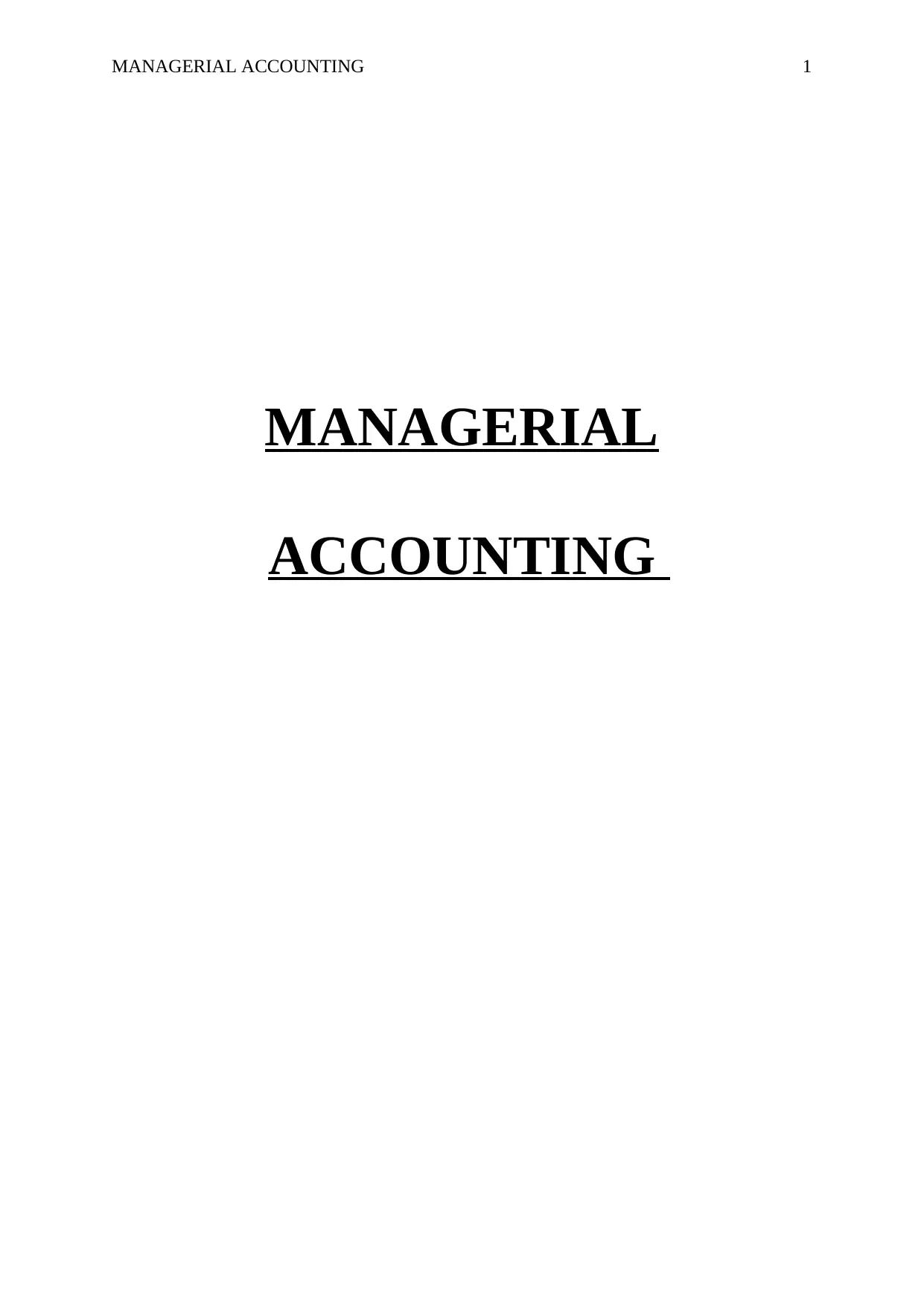
MANAGERIAL ACCOUNTING 1
MANAGERIAL
ACCOUNTING
MANAGERIAL
ACCOUNTING
Paraphrase This Document
Need a fresh take? Get an instant paraphrase of this document with our AI Paraphraser

MANAGERIAL ACCOUNTING 2
Contents
Introduction:...............................................................................................................................3
Calculation per unit using Traditional costing method:.............................................................3
Calculation per unit using ABC costing method:......................................................................4
Profit and Loss statement under Traditional costing method:...................................................6
Profit and Loss statement under ABC costing method:.............................................................6
Over and under absorption costs:...............................................................................................8
Ways of treating the over or under absorption:..........................................................................8
Treatment of over or under applied overheads:.........................................................................9
Conclusion:...............................................................................................................................9
References:...............................................................................................................................11
Contents
Introduction:...............................................................................................................................3
Calculation per unit using Traditional costing method:.............................................................3
Calculation per unit using ABC costing method:......................................................................4
Profit and Loss statement under Traditional costing method:...................................................6
Profit and Loss statement under ABC costing method:.............................................................6
Over and under absorption costs:...............................................................................................8
Ways of treating the over or under absorption:..........................................................................8
Treatment of over or under applied overheads:.........................................................................9
Conclusion:...............................................................................................................................9
References:...............................................................................................................................11
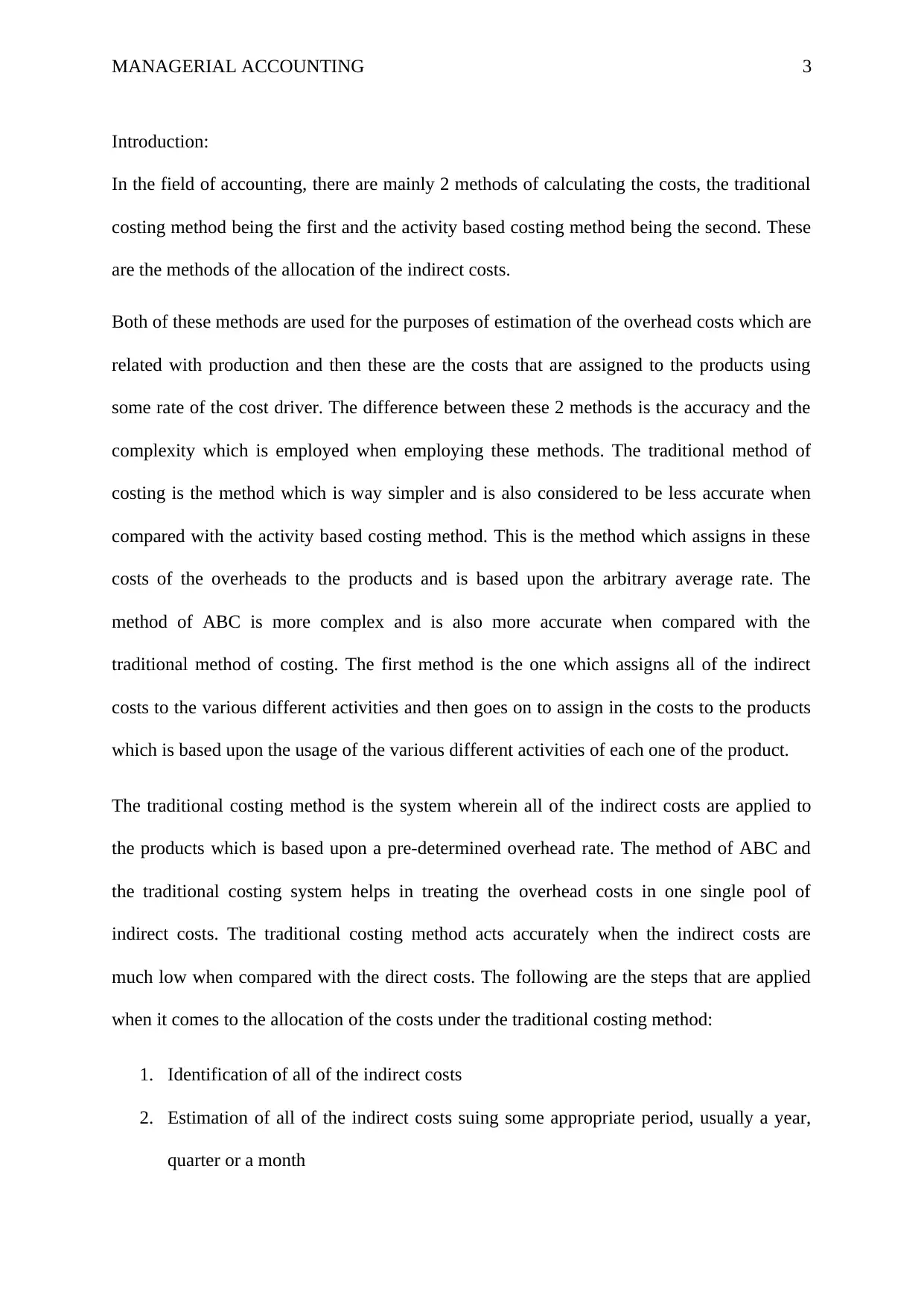
MANAGERIAL ACCOUNTING 3
Introduction:
In the field of accounting, there are mainly 2 methods of calculating the costs, the traditional
costing method being the first and the activity based costing method being the second. These
are the methods of the allocation of the indirect costs.
Both of these methods are used for the purposes of estimation of the overhead costs which are
related with production and then these are the costs that are assigned to the products using
some rate of the cost driver. The difference between these 2 methods is the accuracy and the
complexity which is employed when employing these methods. The traditional method of
costing is the method which is way simpler and is also considered to be less accurate when
compared with the activity based costing method. This is the method which assigns in these
costs of the overheads to the products and is based upon the arbitrary average rate. The
method of ABC is more complex and is also more accurate when compared with the
traditional method of costing. The first method is the one which assigns all of the indirect
costs to the various different activities and then goes on to assign in the costs to the products
which is based upon the usage of the various different activities of each one of the product.
The traditional costing method is the system wherein all of the indirect costs are applied to
the products which is based upon a pre-determined overhead rate. The method of ABC and
the traditional costing system helps in treating the overhead costs in one single pool of
indirect costs. The traditional costing method acts accurately when the indirect costs are
much low when compared with the direct costs. The following are the steps that are applied
when it comes to the allocation of the costs under the traditional costing method:
1. Identification of all of the indirect costs
2. Estimation of all of the indirect costs suing some appropriate period, usually a year,
quarter or a month
Introduction:
In the field of accounting, there are mainly 2 methods of calculating the costs, the traditional
costing method being the first and the activity based costing method being the second. These
are the methods of the allocation of the indirect costs.
Both of these methods are used for the purposes of estimation of the overhead costs which are
related with production and then these are the costs that are assigned to the products using
some rate of the cost driver. The difference between these 2 methods is the accuracy and the
complexity which is employed when employing these methods. The traditional method of
costing is the method which is way simpler and is also considered to be less accurate when
compared with the activity based costing method. This is the method which assigns in these
costs of the overheads to the products and is based upon the arbitrary average rate. The
method of ABC is more complex and is also more accurate when compared with the
traditional method of costing. The first method is the one which assigns all of the indirect
costs to the various different activities and then goes on to assign in the costs to the products
which is based upon the usage of the various different activities of each one of the product.
The traditional costing method is the system wherein all of the indirect costs are applied to
the products which is based upon a pre-determined overhead rate. The method of ABC and
the traditional costing system helps in treating the overhead costs in one single pool of
indirect costs. The traditional costing method acts accurately when the indirect costs are
much low when compared with the direct costs. The following are the steps that are applied
when it comes to the allocation of the costs under the traditional costing method:
1. Identification of all of the indirect costs
2. Estimation of all of the indirect costs suing some appropriate period, usually a year,
quarter or a month
⊘ This is a preview!⊘
Do you want full access?
Subscribe today to unlock all pages.

Trusted by 1+ million students worldwide
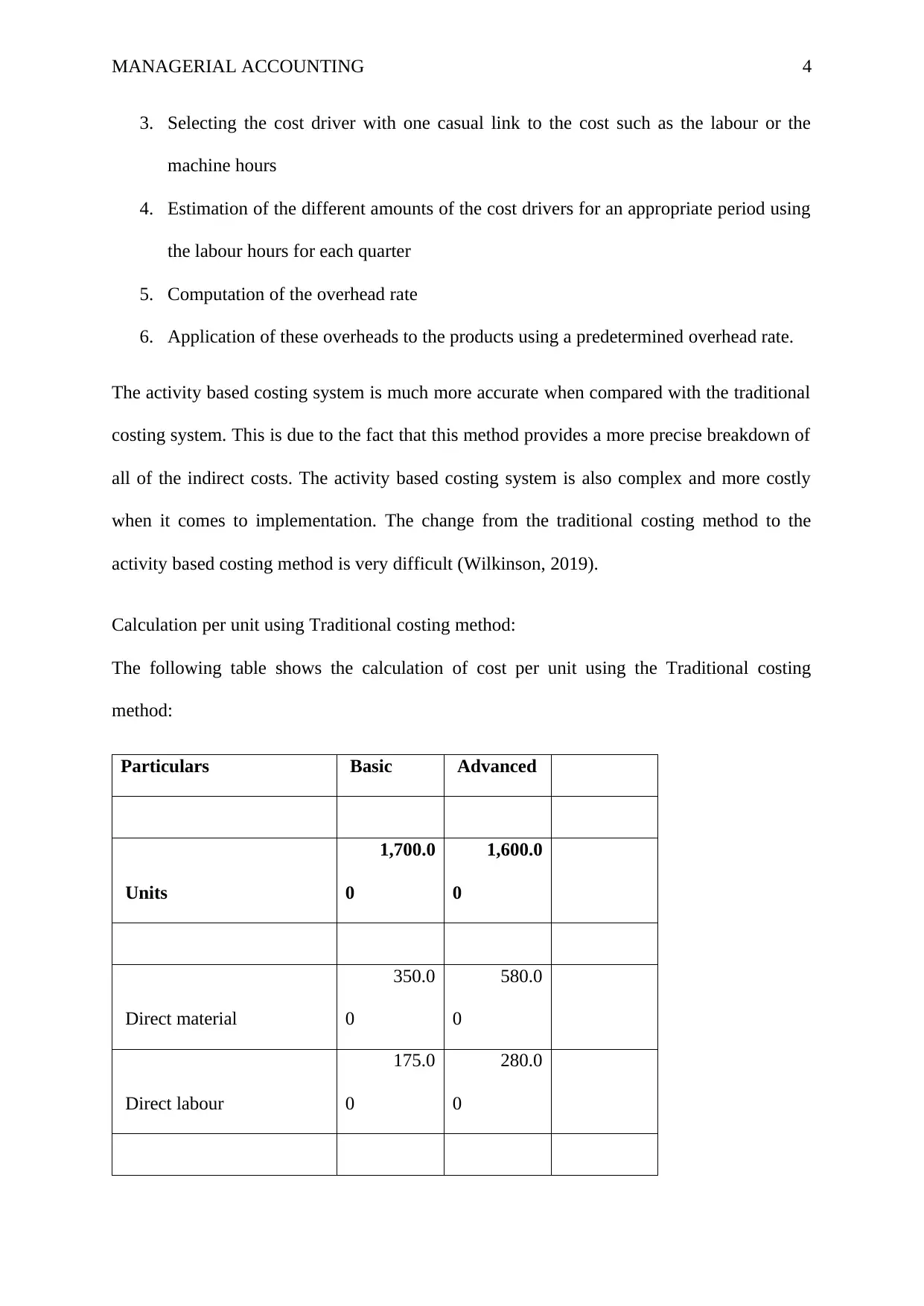
MANAGERIAL ACCOUNTING 4
3. Selecting the cost driver with one casual link to the cost such as the labour or the
machine hours
4. Estimation of the different amounts of the cost drivers for an appropriate period using
the labour hours for each quarter
5. Computation of the overhead rate
6. Application of these overheads to the products using a predetermined overhead rate.
The activity based costing system is much more accurate when compared with the traditional
costing system. This is due to the fact that this method provides a more precise breakdown of
all of the indirect costs. The activity based costing system is also complex and more costly
when it comes to implementation. The change from the traditional costing method to the
activity based costing method is very difficult (Wilkinson, 2019).
Calculation per unit using Traditional costing method:
The following table shows the calculation of cost per unit using the Traditional costing
method:
Particulars Basic Advanced
Units
1,700.0
0
1,600.0
0
Direct material
350.0
0
580.0
0
Direct labour
175.0
0
280.0
0
3. Selecting the cost driver with one casual link to the cost such as the labour or the
machine hours
4. Estimation of the different amounts of the cost drivers for an appropriate period using
the labour hours for each quarter
5. Computation of the overhead rate
6. Application of these overheads to the products using a predetermined overhead rate.
The activity based costing system is much more accurate when compared with the traditional
costing system. This is due to the fact that this method provides a more precise breakdown of
all of the indirect costs. The activity based costing system is also complex and more costly
when it comes to implementation. The change from the traditional costing method to the
activity based costing method is very difficult (Wilkinson, 2019).
Calculation per unit using Traditional costing method:
The following table shows the calculation of cost per unit using the Traditional costing
method:
Particulars Basic Advanced
Units
1,700.0
0
1,600.0
0
Direct material
350.0
0
580.0
0
Direct labour
175.0
0
280.0
0
Paraphrase This Document
Need a fresh take? Get an instant paraphrase of this document with our AI Paraphraser
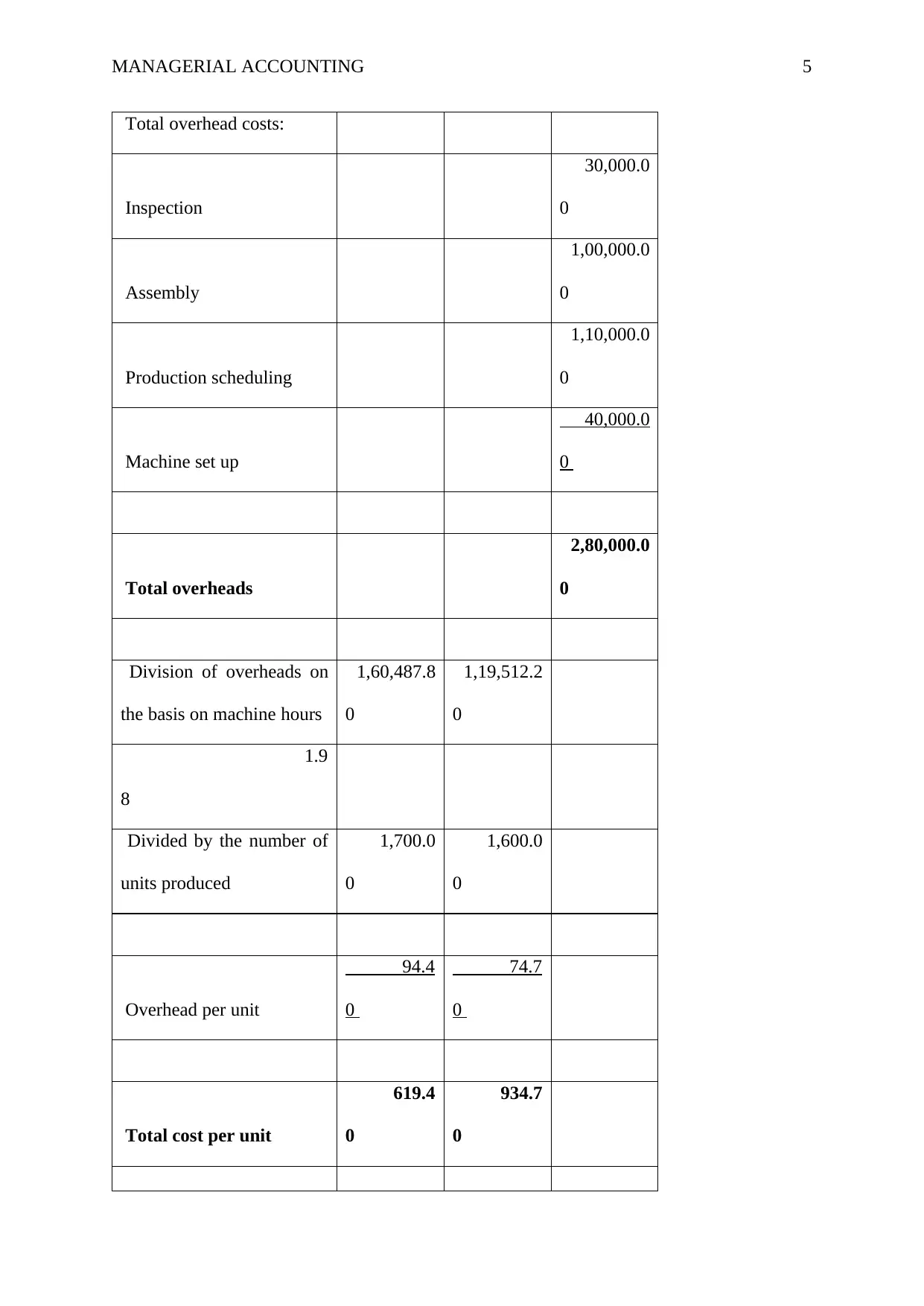
MANAGERIAL ACCOUNTING 5
Total overhead costs:
Inspection
30,000.0
0
Assembly
1,00,000.0
0
Production scheduling
1,10,000.0
0
Machine set up
40,000.0
0
Total overheads
2,80,000.0
0
Division of overheads on
the basis on machine hours
1,60,487.8
0
1,19,512.2
0
1.9
8
Divided by the number of
units produced
1,700.0
0
1,600.0
0
Overhead per unit
94.4
0
74.7
0
Total cost per unit
619.4
0
934.7
0
Total overhead costs:
Inspection
30,000.0
0
Assembly
1,00,000.0
0
Production scheduling
1,10,000.0
0
Machine set up
40,000.0
0
Total overheads
2,80,000.0
0
Division of overheads on
the basis on machine hours
1,60,487.8
0
1,19,512.2
0
1.9
8
Divided by the number of
units produced
1,700.0
0
1,600.0
0
Overhead per unit
94.4
0
74.7
0
Total cost per unit
619.4
0
934.7
0
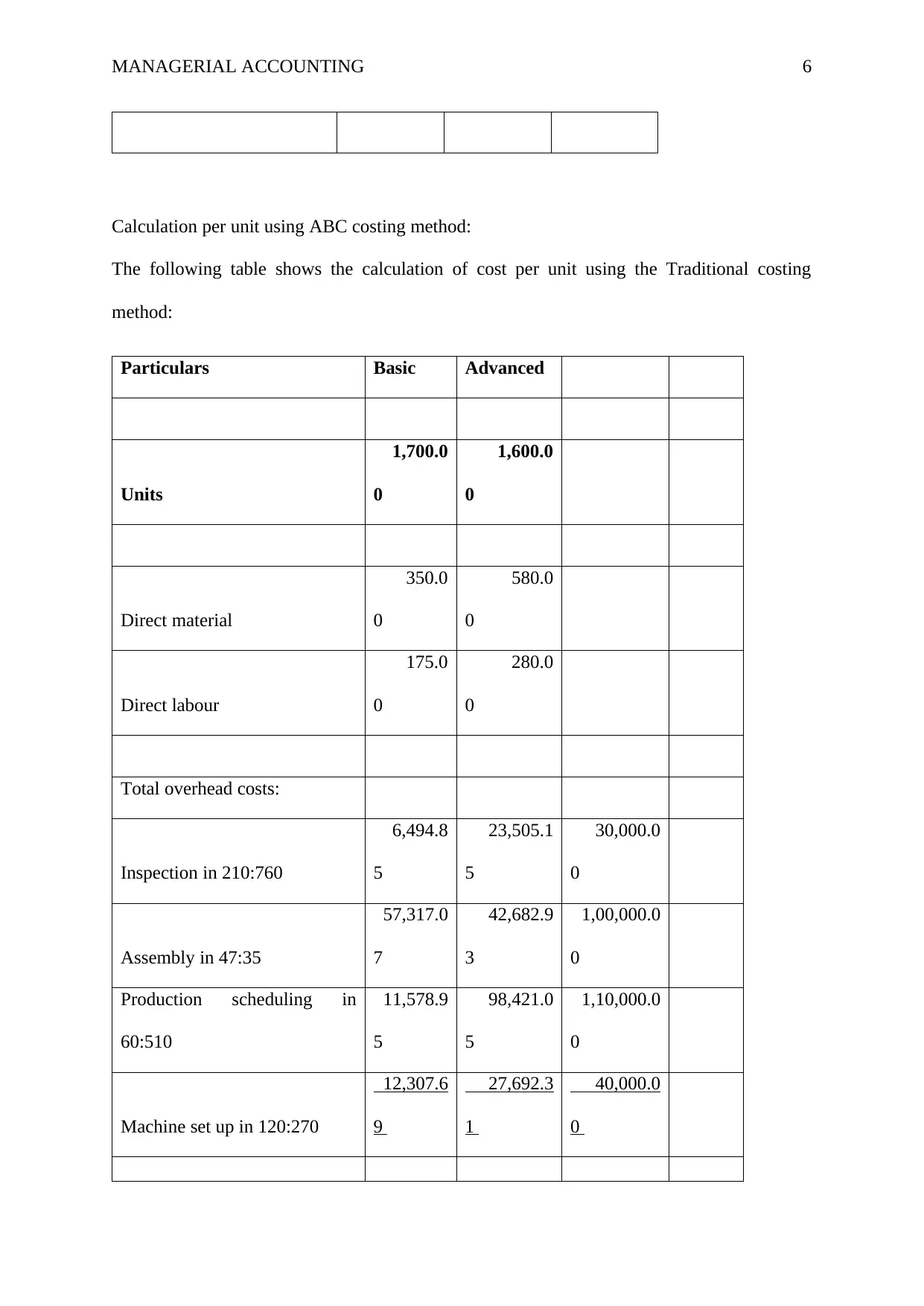
MANAGERIAL ACCOUNTING 6
Calculation per unit using ABC costing method:
The following table shows the calculation of cost per unit using the Traditional costing
method:
Particulars Basic Advanced
Units
1,700.0
0
1,600.0
0
Direct material
350.0
0
580.0
0
Direct labour
175.0
0
280.0
0
Total overhead costs:
Inspection in 210:760
6,494.8
5
23,505.1
5
30,000.0
0
Assembly in 47:35
57,317.0
7
42,682.9
3
1,00,000.0
0
Production scheduling in
60:510
11,578.9
5
98,421.0
5
1,10,000.0
0
Machine set up in 120:270
12,307.6
9
27,692.3
1
40,000.0
0
Calculation per unit using ABC costing method:
The following table shows the calculation of cost per unit using the Traditional costing
method:
Particulars Basic Advanced
Units
1,700.0
0
1,600.0
0
Direct material
350.0
0
580.0
0
Direct labour
175.0
0
280.0
0
Total overhead costs:
Inspection in 210:760
6,494.8
5
23,505.1
5
30,000.0
0
Assembly in 47:35
57,317.0
7
42,682.9
3
1,00,000.0
0
Production scheduling in
60:510
11,578.9
5
98,421.0
5
1,10,000.0
0
Machine set up in 120:270
12,307.6
9
27,692.3
1
40,000.0
0
⊘ This is a preview!⊘
Do you want full access?
Subscribe today to unlock all pages.

Trusted by 1+ million students worldwide

MANAGERIAL ACCOUNTING 7
Total overheads
87,698.5
6
1,92,301.4
4
2,80,000.0
0
Divided by the number of units
produced
1,700.0
0
1,600.0
0
Overhead per unit
51.5
9
120.1
9
Total cost per unit
576.5
9
980.1
9
As could be seen from the above tables, the prices calculated under the ABC method is much
more accurate and are also less. This is mainly due to the following reasons:
1. This method helps in the reduction of the costs and this is done by the way of
providing a meaningful information on the various different opportunities that are
available for the purposes of reducing the costs.
2. This method helps on the activities. Therefore, the management is capable of taking
quality decisions by the way of knowing the nature of each and very activity
3. The method helps in the classification of the activities such as the value adding and
the non-value adding activities. This method helps the management in concentrating
Total overheads
87,698.5
6
1,92,301.4
4
2,80,000.0
0
Divided by the number of units
produced
1,700.0
0
1,600.0
0
Overhead per unit
51.5
9
120.1
9
Total cost per unit
576.5
9
980.1
9
As could be seen from the above tables, the prices calculated under the ABC method is much
more accurate and are also less. This is mainly due to the following reasons:
1. This method helps in the reduction of the costs and this is done by the way of
providing a meaningful information on the various different opportunities that are
available for the purposes of reducing the costs.
2. This method helps on the activities. Therefore, the management is capable of taking
quality decisions by the way of knowing the nature of each and very activity
3. The method helps in the classification of the activities such as the value adding and
the non-value adding activities. This method helps the management in concentrating
Paraphrase This Document
Need a fresh take? Get an instant paraphrase of this document with our AI Paraphraser
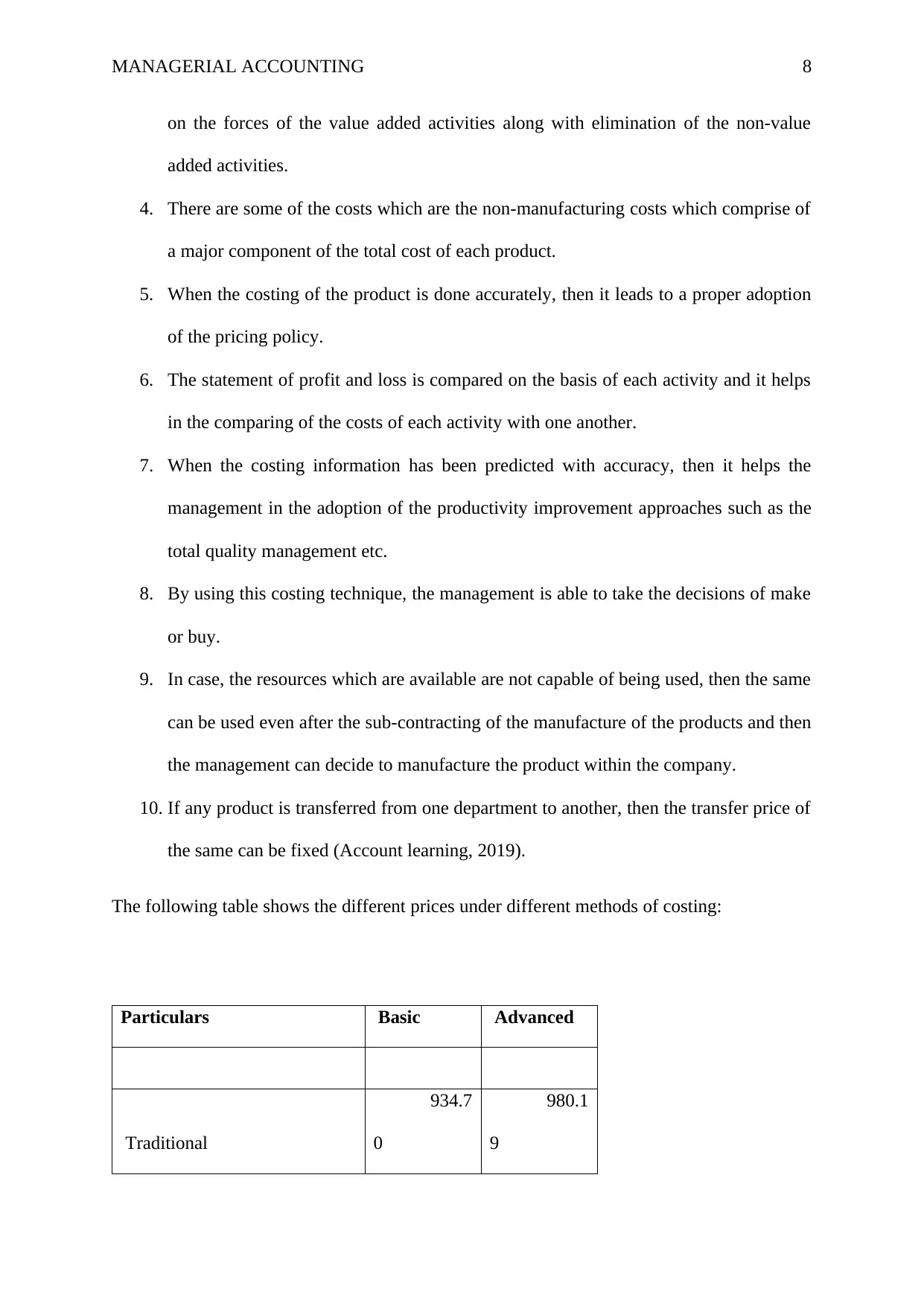
MANAGERIAL ACCOUNTING 8
on the forces of the value added activities along with elimination of the non-value
added activities.
4. There are some of the costs which are the non-manufacturing costs which comprise of
a major component of the total cost of each product.
5. When the costing of the product is done accurately, then it leads to a proper adoption
of the pricing policy.
6. The statement of profit and loss is compared on the basis of each activity and it helps
in the comparing of the costs of each activity with one another.
7. When the costing information has been predicted with accuracy, then it helps the
management in the adoption of the productivity improvement approaches such as the
total quality management etc.
8. By using this costing technique, the management is able to take the decisions of make
or buy.
9. In case, the resources which are available are not capable of being used, then the same
can be used even after the sub-contracting of the manufacture of the products and then
the management can decide to manufacture the product within the company.
10. If any product is transferred from one department to another, then the transfer price of
the same can be fixed (Account learning, 2019).
The following table shows the different prices under different methods of costing:
Particulars Basic Advanced
Traditional
934.7
0
980.1
9
on the forces of the value added activities along with elimination of the non-value
added activities.
4. There are some of the costs which are the non-manufacturing costs which comprise of
a major component of the total cost of each product.
5. When the costing of the product is done accurately, then it leads to a proper adoption
of the pricing policy.
6. The statement of profit and loss is compared on the basis of each activity and it helps
in the comparing of the costs of each activity with one another.
7. When the costing information has been predicted with accuracy, then it helps the
management in the adoption of the productivity improvement approaches such as the
total quality management etc.
8. By using this costing technique, the management is able to take the decisions of make
or buy.
9. In case, the resources which are available are not capable of being used, then the same
can be used even after the sub-contracting of the manufacture of the products and then
the management can decide to manufacture the product within the company.
10. If any product is transferred from one department to another, then the transfer price of
the same can be fixed (Account learning, 2019).
The following table shows the different prices under different methods of costing:
Particulars Basic Advanced
Traditional
934.7
0
980.1
9

MANAGERIAL ACCOUNTING 9
ABC
619.4
0
576.5
9
Profit and Loss statement under Traditional costing method:
The following table shows the relevant calculations:
Profit and Loss statement:
Traditional
method ABC method
Direct material 580.00 580.00
Direct labour 280.00 280.00
Overheads per unit 74.70 120.19
Total cost per unit 934.70 980.19
Add: profit margin @ 30% 280.41 294.06
Selling price 1,215.10 1,274.24
Sales revenue 19,44,165.85 20,38,791.87
Less: costs 14,95,512.20 15,68,301.44
Profit 4,48,653.66 4,70,490.43
ABC
619.4
0
576.5
9
Profit and Loss statement under Traditional costing method:
The following table shows the relevant calculations:
Profit and Loss statement:
Traditional
method ABC method
Direct material 580.00 580.00
Direct labour 280.00 280.00
Overheads per unit 74.70 120.19
Total cost per unit 934.70 980.19
Add: profit margin @ 30% 280.41 294.06
Selling price 1,215.10 1,274.24
Sales revenue 19,44,165.85 20,38,791.87
Less: costs 14,95,512.20 15,68,301.44
Profit 4,48,653.66 4,70,490.43
⊘ This is a preview!⊘
Do you want full access?
Subscribe today to unlock all pages.

Trusted by 1+ million students worldwide
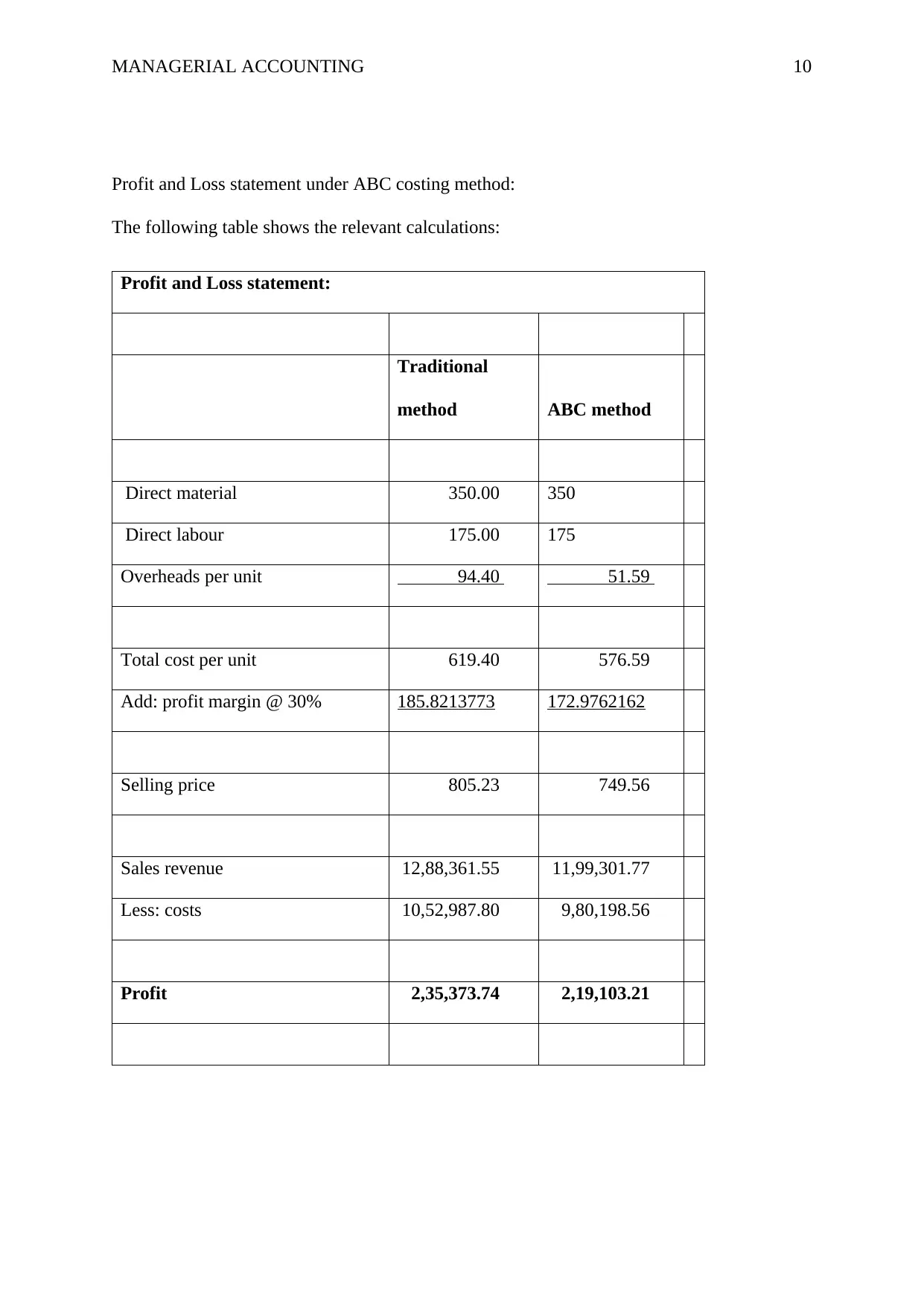
MANAGERIAL ACCOUNTING 10
Profit and Loss statement under ABC costing method:
The following table shows the relevant calculations:
Profit and Loss statement:
Traditional
method ABC method
Direct material 350.00 350
Direct labour 175.00 175
Overheads per unit 94.40 51.59
Total cost per unit 619.40 576.59
Add: profit margin @ 30% 185.8213773 172.9762162
Selling price 805.23 749.56
Sales revenue 12,88,361.55 11,99,301.77
Less: costs 10,52,987.80 9,80,198.56
Profit 2,35,373.74 2,19,103.21
Profit and Loss statement under ABC costing method:
The following table shows the relevant calculations:
Profit and Loss statement:
Traditional
method ABC method
Direct material 350.00 350
Direct labour 175.00 175
Overheads per unit 94.40 51.59
Total cost per unit 619.40 576.59
Add: profit margin @ 30% 185.8213773 172.9762162
Selling price 805.23 749.56
Sales revenue 12,88,361.55 11,99,301.77
Less: costs 10,52,987.80 9,80,198.56
Profit 2,35,373.74 2,19,103.21
Paraphrase This Document
Need a fresh take? Get an instant paraphrase of this document with our AI Paraphraser
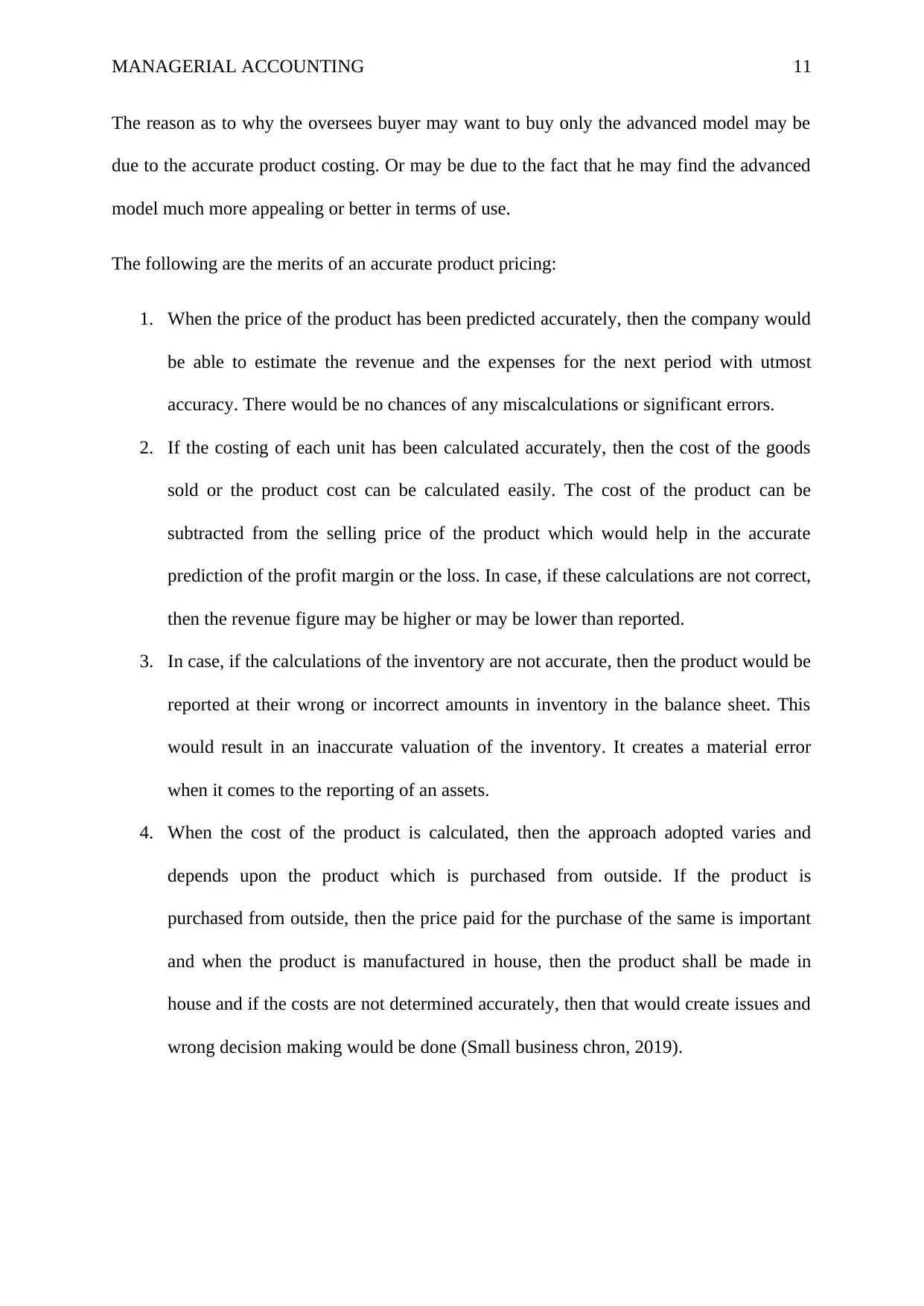
MANAGERIAL ACCOUNTING 11
The reason as to why the oversees buyer may want to buy only the advanced model may be
due to the accurate product costing. Or may be due to the fact that he may find the advanced
model much more appealing or better in terms of use.
The following are the merits of an accurate product pricing:
1. When the price of the product has been predicted accurately, then the company would
be able to estimate the revenue and the expenses for the next period with utmost
accuracy. There would be no chances of any miscalculations or significant errors.
2. If the costing of each unit has been calculated accurately, then the cost of the goods
sold or the product cost can be calculated easily. The cost of the product can be
subtracted from the selling price of the product which would help in the accurate
prediction of the profit margin or the loss. In case, if these calculations are not correct,
then the revenue figure may be higher or may be lower than reported.
3. In case, if the calculations of the inventory are not accurate, then the product would be
reported at their wrong or incorrect amounts in inventory in the balance sheet. This
would result in an inaccurate valuation of the inventory. It creates a material error
when it comes to the reporting of an assets.
4. When the cost of the product is calculated, then the approach adopted varies and
depends upon the product which is purchased from outside. If the product is
purchased from outside, then the price paid for the purchase of the same is important
and when the product is manufactured in house, then the product shall be made in
house and if the costs are not determined accurately, then that would create issues and
wrong decision making would be done (Small business chron, 2019).
The reason as to why the oversees buyer may want to buy only the advanced model may be
due to the accurate product costing. Or may be due to the fact that he may find the advanced
model much more appealing or better in terms of use.
The following are the merits of an accurate product pricing:
1. When the price of the product has been predicted accurately, then the company would
be able to estimate the revenue and the expenses for the next period with utmost
accuracy. There would be no chances of any miscalculations or significant errors.
2. If the costing of each unit has been calculated accurately, then the cost of the goods
sold or the product cost can be calculated easily. The cost of the product can be
subtracted from the selling price of the product which would help in the accurate
prediction of the profit margin or the loss. In case, if these calculations are not correct,
then the revenue figure may be higher or may be lower than reported.
3. In case, if the calculations of the inventory are not accurate, then the product would be
reported at their wrong or incorrect amounts in inventory in the balance sheet. This
would result in an inaccurate valuation of the inventory. It creates a material error
when it comes to the reporting of an assets.
4. When the cost of the product is calculated, then the approach adopted varies and
depends upon the product which is purchased from outside. If the product is
purchased from outside, then the price paid for the purchase of the same is important
and when the product is manufactured in house, then the product shall be made in
house and if the costs are not determined accurately, then that would create issues and
wrong decision making would be done (Small business chron, 2019).
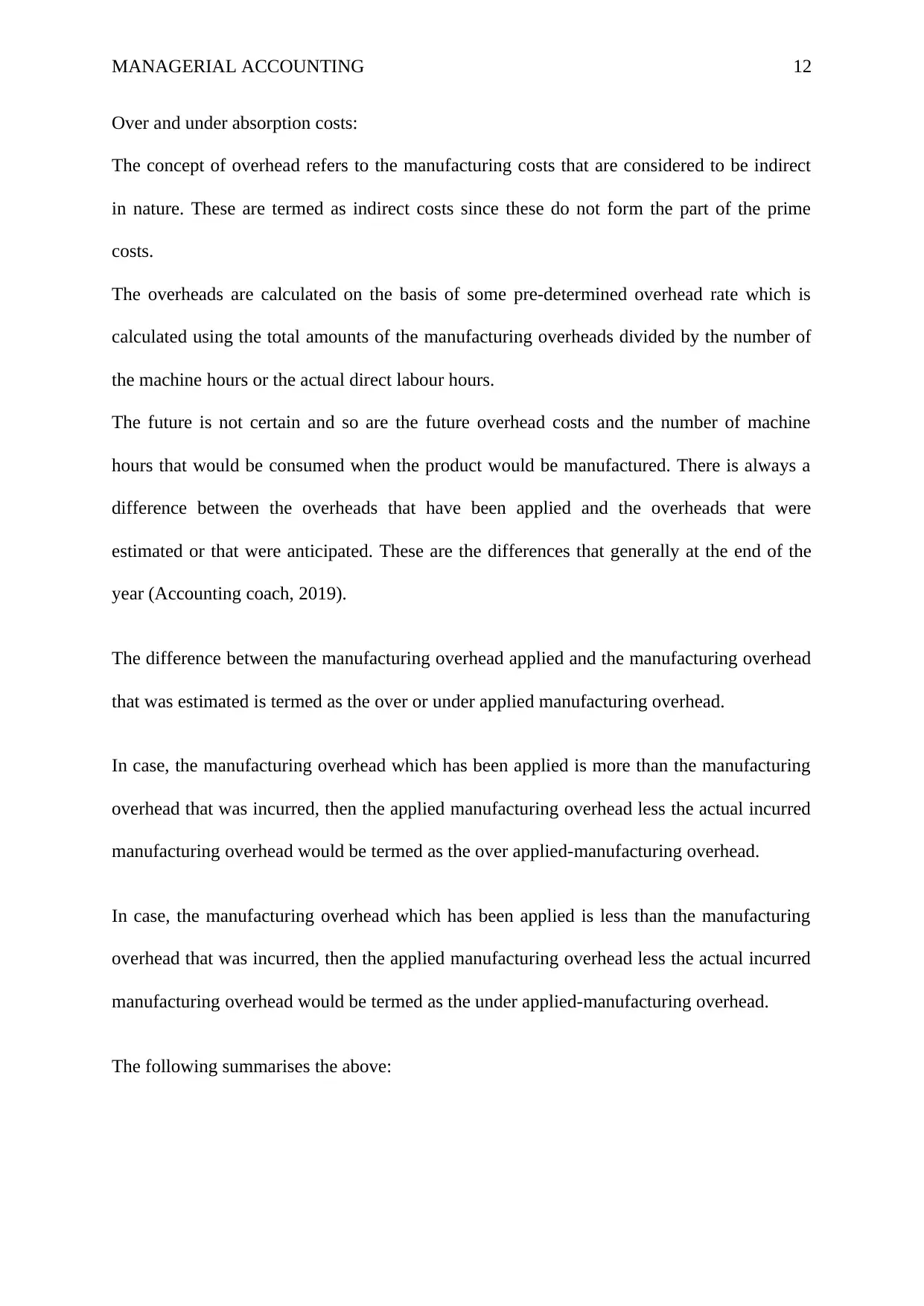
MANAGERIAL ACCOUNTING 12
Over and under absorption costs:
The concept of overhead refers to the manufacturing costs that are considered to be indirect
in nature. These are termed as indirect costs since these do not form the part of the prime
costs.
The overheads are calculated on the basis of some pre-determined overhead rate which is
calculated using the total amounts of the manufacturing overheads divided by the number of
the machine hours or the actual direct labour hours.
The future is not certain and so are the future overhead costs and the number of machine
hours that would be consumed when the product would be manufactured. There is always a
difference between the overheads that have been applied and the overheads that were
estimated or that were anticipated. These are the differences that generally at the end of the
year (Accounting coach, 2019).
The difference between the manufacturing overhead applied and the manufacturing overhead
that was estimated is termed as the over or under applied manufacturing overhead.
In case, the manufacturing overhead which has been applied is more than the manufacturing
overhead that was incurred, then the applied manufacturing overhead less the actual incurred
manufacturing overhead would be termed as the over applied-manufacturing overhead.
In case, the manufacturing overhead which has been applied is less than the manufacturing
overhead that was incurred, then the applied manufacturing overhead less the actual incurred
manufacturing overhead would be termed as the under applied-manufacturing overhead.
The following summarises the above:
Over and under absorption costs:
The concept of overhead refers to the manufacturing costs that are considered to be indirect
in nature. These are termed as indirect costs since these do not form the part of the prime
costs.
The overheads are calculated on the basis of some pre-determined overhead rate which is
calculated using the total amounts of the manufacturing overheads divided by the number of
the machine hours or the actual direct labour hours.
The future is not certain and so are the future overhead costs and the number of machine
hours that would be consumed when the product would be manufactured. There is always a
difference between the overheads that have been applied and the overheads that were
estimated or that were anticipated. These are the differences that generally at the end of the
year (Accounting coach, 2019).
The difference between the manufacturing overhead applied and the manufacturing overhead
that was estimated is termed as the over or under applied manufacturing overhead.
In case, the manufacturing overhead which has been applied is more than the manufacturing
overhead that was incurred, then the applied manufacturing overhead less the actual incurred
manufacturing overhead would be termed as the over applied-manufacturing overhead.
In case, the manufacturing overhead which has been applied is less than the manufacturing
overhead that was incurred, then the applied manufacturing overhead less the actual incurred
manufacturing overhead would be termed as the under applied-manufacturing overhead.
The following summarises the above:
⊘ This is a preview!⊘
Do you want full access?
Subscribe today to unlock all pages.

Trusted by 1+ million students worldwide
1 out of 16
Related Documents
Your All-in-One AI-Powered Toolkit for Academic Success.
+13062052269
info@desklib.com
Available 24*7 on WhatsApp / Email
![[object Object]](/_next/static/media/star-bottom.7253800d.svg)
Unlock your academic potential
Copyright © 2020–2025 A2Z Services. All Rights Reserved. Developed and managed by ZUCOL.




